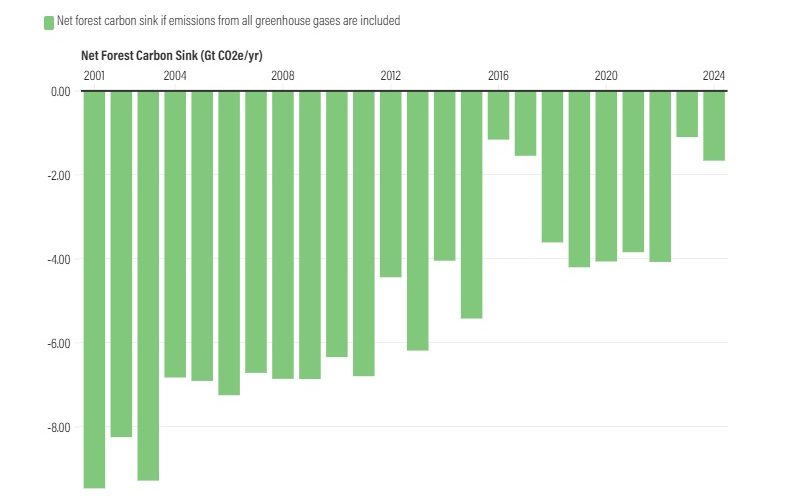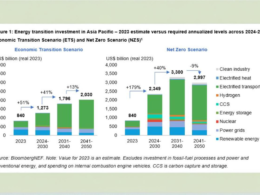For decades, forests have quietly played a vital role in cooling the planet, absorbing vast quantities of carbon dioxide and helping regulate Earth’s temperature. However, a growing body of evidence suggests this natural climate buffer is under increasing threat, with recent data indicating a sharp decline in the ability of forests to absorb carbon emissions.
According to new findings from the World Resources Institute’s Global Forest Watch and Land & Carbon Lab, 2023 and 2024 witnessed a dramatic weakening in the global forest carbon sink. A surge in extreme wildfires meant that forests absorbed only around 25% of the carbon they typically would—down from the average 30% of annual emissions from fossil fuels usually removed by forests and vegetation. The year 2023 marked the lowest level of forest carbon absorption in more than two decades.
This alarming dip is part of a broader trend, with deforestation, forest degradation, and climate-related stressors undermining forests’ ability to serve as net carbon sinks. The gap between emissions from forest loss and the carbon removed by standing and regrowing forests is narrowing, raising fears that forests may soon become net carbon sources.
Emissions: Fires, farming and forest loss
An analysis of 25 years of satellite and emissions data reveals that over 80% of forest-related emissions stem from human activities—chiefly clearing land for agriculture. Between 2001 and 2024, agriculture was responsible for 53% of emissions linked to global tree cover loss.
But fires are now emerging as an even more pressing threat. In 2023 and 2024, forest fires — from the Amazon to Siberia — released over 4 gigatonnes of greenhouse gases annually, including carbon dioxide, methane and nitrous oxide. This is more than double the typical annual fire-related emissions and equivalent to roughly one-third of China’s annual emissions.
Canada alone contributed disproportionately to this global total. In 2023, the country accounted for 65% of global fire-related tree cover loss and 79% of associated emissions, with many fires burning deep into carbon-rich peatlands. Even with reduced fire activity in 2024, Canada was still responsible for over half of global forest fire emissions.
Where carbon removals still hold
Despite mounting pressures, global forests remain a net carbon sink—though a fragile one. For every hectare of forest lost between 2001 and 2024, seven hectares remained, continuing to absorb carbon and provide essential biodiversity and water cycle services.
Notably, two-thirds of global carbon removals since 2000 have come from “middle-aged” secondary forests—those regrowing for 20 years or more. These regenerating forests are especially efficient at sequestering carbon. Meanwhile, younger forests under 20 years contribute around 6% of removals, while primary rainforests and intact forest landscapes, despite covering 27% of global forest area, account for just 13% of removals.
Tree plantations, including those used for commercial crops and timber, comprise only 4% of forest area yet contribute 13% of removals due to their rapid growth rates. Mangroves, though making up a mere 0.2% of global forests, account for 2% of carbon removals due to their dense soil carbon storage.
Pathways to preserve the forest carbon sink
The WRI report outlines eight key strategies to preserve and expand the forest carbon sink:
- Prevent further forest loss: Most carbon removals come from existing forests. Halting deforestation is paramount.
- Reduce fire risk: Proactive fire management using prescribed burns, traditional knowledge, and modern monitoring tools can mitigate risks.
- Sustainably manage working forests: Techniques like longer harvest rotations and reduced-impact logging can enhance carbon uptake.
- Accelerate ecological restoration: Degraded forest areas should be naturally or assistedly restored—not simply replanted.
- Empower Indigenous communities: Indigenous territories have proven more resilient carbon sinks, yet they receive limited climate finance.
- Use timely climate data: Platforms like Global Forest Watch must be coupled with decisive action.
- Clean up global supply chains: Commodities such as beef, soy and palm oil must be made deforestation-free in reality, not just on paper.
- Cut fossil fuel emissions: Forests cannot offset continued fossil fuel use; systemic emissions reductions are essential.
Time is running out
The year 2024 was the hottest on record, with global temperatures briefly surpassing the 1.5°C threshold. Scientists warn that unless urgent steps are taken to stabilise the climate system, such conditions may soon become the norm.
Forests are resilient but not invincible. Their ability to continue absorbing carbon is finite and increasingly fragile. Reimagining forests as critical infrastructure in the fight against climate change—not merely as resources for timber or land—is essential.
The preservation and restoration of the world’s forests, the report concludes, is not a charitable endeavour, but a necessity for planetary survival.





















